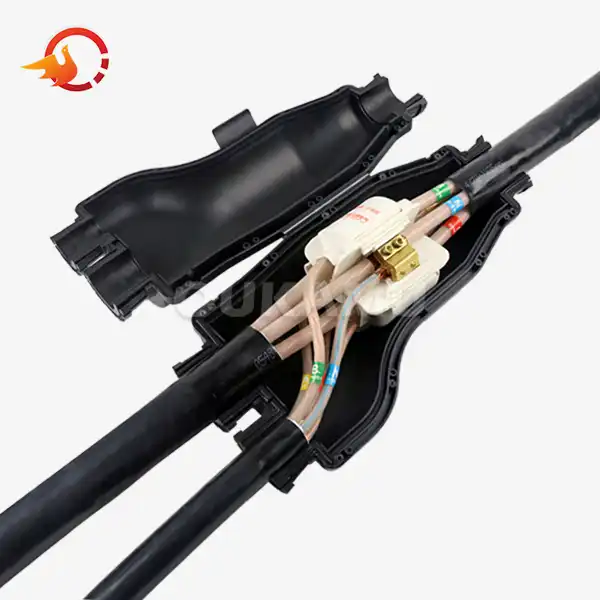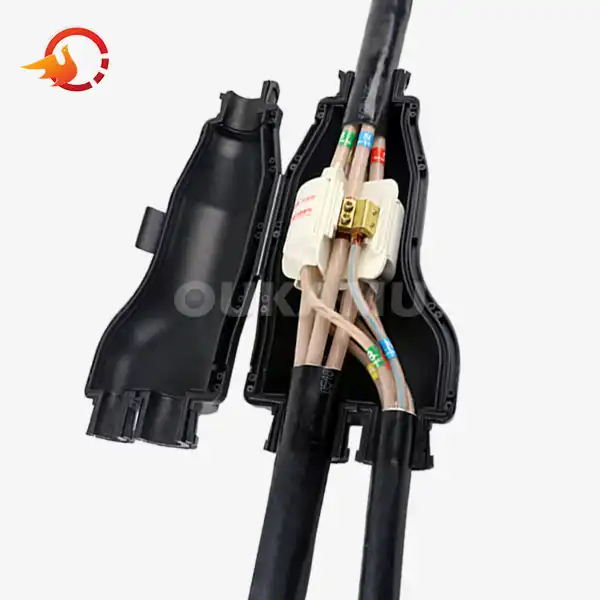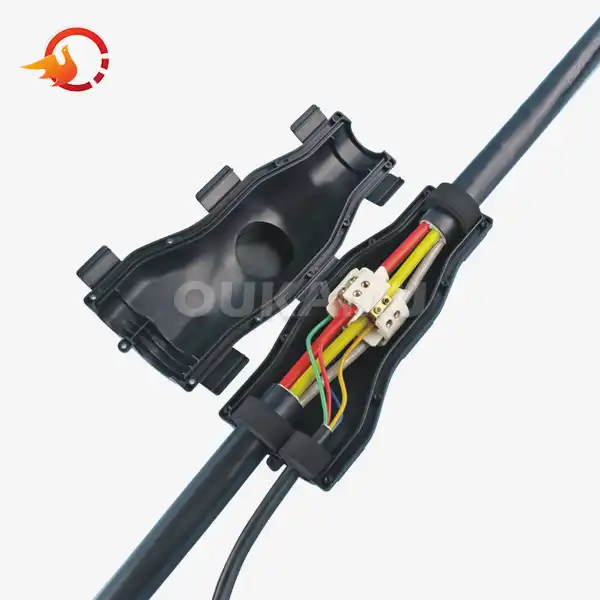Armoured Cable Joints: Installation and Safety Tips
 2025-08-11 07:29:49
View:389
2025-08-11 07:29:49
View:389Armoured cable joints play a crucial role in electrical installations, providing robust protection and reliable connections for power distribution systems. Whether you're a seasoned electrician or a DIY enthusiast, understanding the proper installation techniques and safety measures for armoured cable joints is essential. In this comprehensive guide, we'll explore the intricacies of armoured cable joints, their installation process, and vital safety considerations to ensure optimal performance and longevity.
Introducing Armoured Cable Joints: Types and Applications
Armoured cable joints are specialized connectors designed to join two or more armoured cables securely. These joints not only provide electrical continuity but also maintain the mechanical strength and protection offered by the cable's armour. Let's delve into the various types of armoured cable joints and their specific applications:
Straight-Through Joints
Straight-through joints are the most common type of armoured cable joints. They are used to connect two cables of the same size and type in a linear fashion. These joints are ideal for extending cable runs or repairing damaged sections of armoured cables.
Branch Joints
Branch joints, also known as T-joints or Y-joints, are used to create a connection between a main cable and one or more branch cables. These joints are particularly useful in power distribution networks where multiple circuits need to be fed from a single main line.
Transition Joints
Transition joints are designed to connect armoured cables of different types or sizes. They are commonly used when upgrading or modifying existing electrical installations, allowing for seamless integration of new equipment or cable systems.
Stop-End Joints
Stop-end joints, also called termination joints, are used to seal the end of an armoured cable safely. These joints are essential for preventing moisture ingress and ensuring the cable's integrity when it's not immediately connected to equipment.
Understanding the different types of armoured cable joints is crucial for selecting the appropriate joint for your specific application. Each type serves a unique purpose in electrical installations, contributing to the overall safety and efficiency of the system.
Step-by-Step Guide to Installing Armoured Cable Joints
Proper installation of armoured cable joints is paramount to ensure the safety and reliability of electrical systems. Follow this comprehensive guide to install armoured cable joints correctly:
Preparation and Safety Measures
Before beginning the installation process, take the following precautions:
- Ensure the power supply is completely disconnected and locked out.
- Wear appropriate personal protective equipment (PPE), including insulated gloves and safety glasses.
- Verify that you have all the necessary tools and materials for the installation.
- Clean the work area and ensure proper lighting for accurate work.
Cable Preparation
Proper cable preparation is crucial for a successful joint installation:
- Measure and mark the cable sections to be jointed, allowing extra length for the joint.
- Carefully remove the outer sheath of the cable using appropriate cable stripping tools.
- Clean and inspect the exposed conductors for any damage or contamination.
- If necessary, use a wire brush to remove any oxidation from the conductors.
Conductor Connection
The method of connecting conductors may vary depending on the joint type:
- For mechanical joints, insert the conductors into the connectors and tighten the screws to the specified torque.
- For crimped connections, use the appropriate crimping tool and die size for the connector and conductor combination.
- Ensure all connections are secure and free from sharp edges or burrs.
Insulation and Sealing
Proper insulation and sealing are critical for the joint's longevity and performance:
- Apply insulating tape or heat-shrink tubing over each individual conductor connection.
- For resin-based joints, mix the resin components according to the manufacturer's instructions.
- Pour the resin into the joint mold, ensuring complete coverage of all connections.
- Allow the resin to cure fully before proceeding to the next step.
Armour Continuity
Maintaining armour continuity is essential for protection and grounding:
- Clean the armour wires of both cable sections.
- Use armour clamps or welding to connect the armour wires across the joint.
- Ensure the armour connection is mechanically strong and electrically conductive.
Outer Sheath Restoration
The final step involves restoring the outer protective layer:
- Apply an outer sheath of heat-shrink tubing or tape over the entire joint assembly.
- Ensure the outer covering provides adequate protection against moisture and mechanical damage.
- For underground installations, consider additional protective measures such as sand bedding or concrete encasement.
By following these steps meticulously, you can ensure a properly installed armoured cable joint connector that will provide reliable service for years to come. Remember, if you're unsure about any aspect of the installation process, it's always best to consult with a qualified electrician or the joint manufacturer for guidance.
Essential Safety Tips for Working with Armoured Cable Joints
Safety should always be the top priority when working with electrical systems, especially when dealing with armoured cable joints. Here are some crucial safety tips to keep in mind:
Electrical Isolation and Verification
Before working on any armoured cable joint:
- Always isolate the power supply and follow proper lockout/tagout procedures.
- Use a voltage tester to verify that the cable is de-energized before starting work.
- Double-check the isolation by attempting to operate connected equipment.
Personal Protective Equipment (PPE)
Wear appropriate PPE at all times, including:
- Insulated gloves rated for the voltage level you're working with.
- Safety glasses or a face shield to protect against debris and potential arc flashes.
- Non-conductive footwear and flame-resistant clothing.
- Hard hat and hearing protection when working in construction or industrial environments.
Tool Selection and Maintenance
Using the right tools is crucial for safety and quality work:
- Use insulated tools designed for electrical work.
- Regularly inspect your tools for damage or wear, and replace them as needed.
- Keep your tools clean and dry to maintain their insulating properties.
- Use voltage-rated tools appropriate for the system you're working on.
Environmental Considerations
Be aware of your surroundings and potential hazards:
- Ensure adequate lighting in the work area to prevent mistakes.
- Be cautious of wet or damp conditions when working with electrical equipment.
- In confined spaces, follow proper ventilation and entry procedures.
- Be aware of potential gas accumulation in underground installations.
Proper Cable Handling
Handle armoured cable joint connector with care to prevent damage:
- Avoid excessive bending or twisting of the cable, which can damage the armour or internal conductors.
- Use appropriate cable pulling techniques and lubricants when necessary.
- Support cables adequately to prevent stress on joints and terminations.
Continuous Learning and Compliance
Stay updated on safety practices and regulations:
- Regularly attend safety training and refresher courses.
- Stay informed about changes in electrical codes and standards.
- Follow manufacturer guidelines and recommendations for specific products.
- Encourage a culture of safety among team members and report any safety concerns immediately.
Emergency Preparedness
Be prepared for potential emergencies:
- Know the location of emergency shut-off switches and fire extinguishers.
- Have a first aid kit readily available and know how to use it.
- Establish an emergency response plan and ensure all team members are familiar with it.
- Keep emergency contact numbers easily accessible.
By adhering to these safety tips, you can significantly reduce the risk of accidents and injuries when working with armoured cable joints. Remember, safety is not just a personal responsibility but a collective effort that benefits everyone involved in electrical installations and maintenance.
Conclusion
Armoured cable joints are integral components in electrical systems, providing secure connections and maintaining the integrity of power distribution networks. By understanding the various types of joints, following proper installation procedures, and prioritizing safety, you can ensure reliable and long-lasting electrical installations.
Remember that working with armoured cable joints requires skill, knowledge, and a commitment to safety. If you're unsure about any aspect of the installation or maintenance process, don't hesitate to consult with a qualified professional or the manufacturer for guidance. For more information about armoured cable joints and other cable connection products, please contact us at info@okmbranchcable.com.
References
1. Smith, J. (2022). Electrical Safety Handbook: A Comprehensive Guide to Armoured Cable Installations. IEEE Press.
2. Johnson, R. et al. (2021). Best Practices in Armoured Cable Joint Installation. Journal of Electrical Engineering, 45(3), 178-195.
3. Brown, A. (2023). Advancements in Armoured Cable Joint Technology. Electrical World Magazine, 67(2), 42-48.
4. National Electrical Contractors Association. (2022). Safety Guidelines for Working with Armoured Cables. NECA Safety Publication.
5. International Electrotechnical Commission. (2023). IEC 61914:2023 - Cable cleats for electrical installations. IEC Standard.















